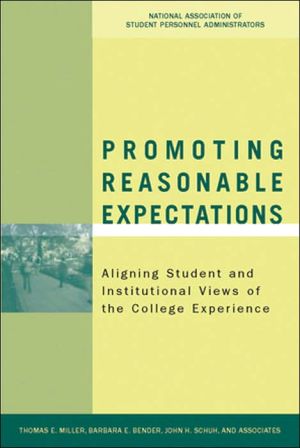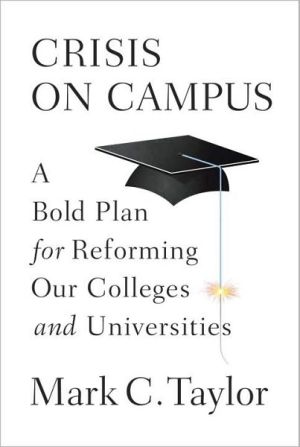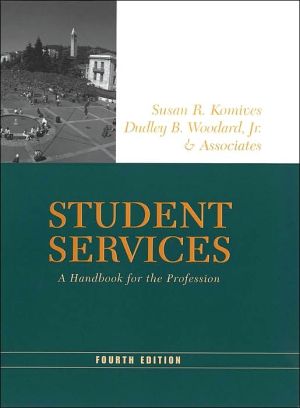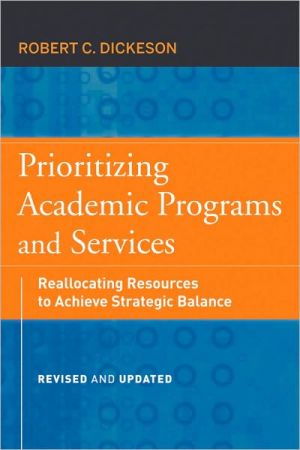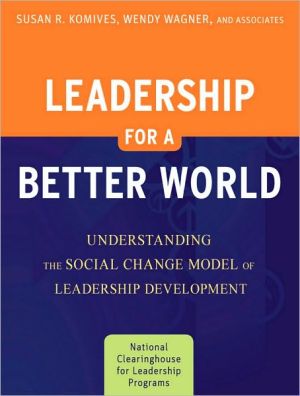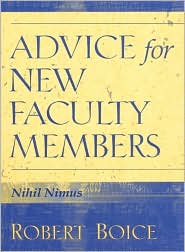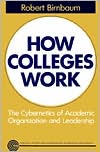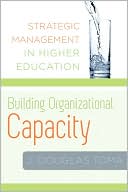Promoting Reasonable Expectations: Aligning Student and Institutional Views of the College Experience
Praise for Promoting Reasonable Expectations\ "If higher education leaders want to understand how best to deal with the growing and complex challenge of meeting students' expectations, of telling them in detail what they need to know about college life, they'd better read this book. It's a thoughtful volume, rich in research on the large gap between what students expect from college and what they get. It deserves a wide audience among presidents, faculty leaders, academic administrators, and...
Search in google:
Sponsored by the National Association of Student Personnel Administrators, this collection explores from several perspectives the dissonances and contrasts between student expectations and experiences. The papers examine topics such as environmental influences, beliefs about paying for college, campus services and degree attainment. They also present recommendations for improving institutional performance in response to student expectations. Annotation ©2004 Book News, Inc., Portland, OR
Promoting Reasonable Expectations\ \ By Thomas E. Miller \ John Wiley & Sons\ ISBN: 0-7879-7624-5 \ \ \ Chapter One\ Introduction\ Thomas E. Miller\ Colleges in the United States have usually had success conveying to students the institutions' expectations of student performance. There are many examples of how colleges do this. Institutions publish codes of conduct that establish standards of behavior for students and sets of rules, regulations, and procedures for addressing violations. Students entering college are given clear indications by their institutions regarding how they are expected to behave.\ Institutions also make clear what standards must be met by students to attain degrees. Students are informed about how many courses they need to take, as well as which ones are needed for particular degrees. In the classroom, students receive syllabi that establish what instructors expect of students, what academic exercises will be conducted, and what performance levels will lead to various grading outcomes. In their academic work, in the residence halls, and on athletic fields, students are informed about what they are expected to do and how they are expected to perform. One might argue that students may not always pay careful attention to the expectations that institutions establish for them, but it seems clear that colleges articulate them, whether they are heeded or not.\ Although the relationship between students and colleges is important to both, the explication of anticipated behavior may be a bit one-sided. Institutions expend considerable effort detailing what they expect of students, but it appears as though much less energy goes into determining what students expect of institutions. How does an institution go about determining what students expect? How do expectations of students affect their performance, and how does the performance of colleges compare to what students expect?\ Nobody wants to deny that individuals sometimes have rather romantic notions about their futures. The optimism often associated with new ventures, like buying a car, starting a new job, getting married, or beginning college, helps one feel good about the risks involved in taking on new things. The aspirations of students should not be denied to them. The principles of aiming high and being personally ambitious are laudable ideas. However, some students have what would be considered unreasonable expectations of college and of themselves.\ There are students who move into residence halls thinking that their roommates will become their lifelong friends. Residence hall administrators know that this is usually not the case. The optimism associated with the start of the first semester may have some students anticipating close, warm, and supportive relationships with their instructors and expecting wondrous stimulation in the classroom. Those conditions may unfold, but often they do not. Some students expect to be able to handle the academic responsibilities of college in a way similar to how they did in high school.\ The preceding establishes that part of the challenge is to inform students about the realities of college and negotiate with them to help them form expectations that are sound. Colleges need to help students develop realistic pictures about the college experience. However, a necessary step is to determine what exactly students do expect. Institutions can hardly correct unrealistic notions of the experience without knowing they exist.\ One of the most important sources of data for this project has been the College Student Expectations Questionnaire (CSXQ), a project managed at Indiana University. Institutions voluntarily participate in the project and administer a questionnaire to incoming students before they begin classes. The study helps institutions establish what their incoming students believe will occur in their college-going experience. It provides a glimpse into the ways in which students are uninformed or misinformed about college life and learning and allows institutions to frame programs and activities to adjust how students are prepared for their experiences. The background and research reliability of CSXQ are explained in Chapter 3 by George D. Kuh and colleagues.\ Another useful institutional research tool is the Cooperative Institutional Research Program (CIRP), managed by the Higher Educational Research Institute at the University of California at Los Angeles. Several items in the CIRP survey point to information about what students might expect of the college experience, but one in particular collects responses about the likelihood, in the mind of the students, that they will have certain experiences, such as dropping out, getting a job, or participating in a sports team. The technical details of the CIRP research are explained in Chapter 9 by Gwendolyn J. Dungy, Patricia A. Rissmeyer, and Gregory Roberts.\ One of the limitations of this project has been that available research is incomplete. Not much data are available regarding expectations held across the full range of student and institutional characteristics. Little is published about the expectations of students over 30 years old or for students who are attending college part time or those engaged in distance learning. In particular, there is little to compare the expectations of students with those characteristics with those who recently graduated from high school and attend residential colleges.\ This project also focuses entirely on undergraduate students. Even were we inclined, the design team could not have included graduate and professional school students in its analyses, because studies about their expectations for their learning and educational experiences were not readily available.\ Clearly, the landscape of higher education has changed, but research about the thinking of students regarding what they will encounter in college has not kept pace with those changes. We found little information about students pointed toward educational experiences that differ from historically traditional colleges and universities. We do not know much about the expectations of students attending trade or vocational schools or for those enrolled at proprietary institutions. There may be research about those institutions and those students, but we did not locate any that related to student expectations as compared to other types of colleges and universities.\ Where do unreasonable expectations arise? What are the conditions under which students come to believe that their experiences will differ from what is known about college life and learning? Part of the answer is that the enrollment management process, beginning with the recruitment of students, is highly competitive. College recruiters are often evaluated on their ability to successfully enroll students and persuade them that a particular college will meet their needs and help them realize their dreams. Admissions and recruitment staff are less apt to be rewarded on the basis of how well they match student interests with college realities or on how well the students they recruit persist to degrees. This is a phenomenon with which higher education needs to come to grips.\ At the same time, institutions should also evaluate carefully how well they meet the needs of the students they admit. The persistence rates we have observed clearly point to a problem, and it is short-sighted for colleges to see attrition as a problem (or failure) of the student. Action is needed to address these concerns. Enrollment management is a broad principle that guides many institutions and may help inform this issue. The principles of enrollment management involve broad engagement with students across the entire time of their connection with institutions, not just at recruitment. Institutions that subscribe to that notion may find better, more lasting connections with their students.\ Another issue facing college admissions staff members is related to the nature and character of the high school generation now coming to college. Those coming directly from high school are certainly not the only student constituency that colleges serve; they are not even the majority, but they do form a cohort of sorts. The "new millennials" are different from previous generations and need to be understood by recruiters, administrators, and faculty members alike. Their interests, backgrounds, and nature give rise to new sorts of expectations, and those expectations must be understood. The institution that behaves as if students are the same as they were 10 or 20 years ago will be poorly prepared for the reality of this generation (Howe & Strauss, 2003).\ Although it would be a worthy subject, this book does not address what institutions and faculty expect of students. That is a useful notion, and articulating clear (and high) expectations of students is one way in which institutions can affect what students expect of themselves and of their college-going experience. Establishing expectations is a way for institutions to engage students, set terms for their experiences, and reframe expectations that might be unreasonable or unrealistic. Therefore, although it is not the subject of this book, it is a worthy notion and not unrelated to the process of framing reasonable student expectations.\ Contents and Organization\ This book intends to describe what is known about the expectations of students in various aspects of their relationships with colleges, including the classroom setting, student services, campus life, and so forth. After discussion of those expectations, what is known about the real experiences of students is presented. The dissonance between expectations and real experiences is discussed, followed by suggestions, where appropriate, about what institutions might do to close any demonstrated gaps between expectations and experience. In recognition of the diversity of American higher education, there are two chapters that address how student expectations vary, respectively, by individual characteristics and by institutional type. The text also addresses how the expectations of other constituencies affect the student-institution relationship. Before the Conclusion is a collection of essays written from interviews with a collection of college presidents and leaders of professional associations of the higher educational community.\ Chapter 1 presents the framework and collection of principles that guided the design of the text. Chapter 2 was written by Jeffrey A. Howard, a member of the psychology faculty at Eckerd College, with a contribution from Robert M. Gonyea of Indiana University. Howard explores the psychological premise of expectations, how unmet expectations affect us, and why it is useful for us to consider them in the context of student relationships with higher educational institutions. He describes the psychological framework for the establishment of expectations and the stress that we encounter when things do not turn out as we had expected. Howard explains the ways in which our expectations affect human behavior. His chapter is largely pointed toward the expectations associated with late adolescence, so aspects of his work apply best to students coming to higher education directly from high school, but many of the principles he presents are applicable to older students, also.\ Chapter 3 was written by George D. Kuh, Robert M. Gonyea, and Julie M. Williams, all of Indiana University. They focus on research about student expectations relative to the teaching and learning environment and how those expectations differ from what actually happens. Indiana University is the home for the College Student Expectations Questionnaire (CSXQ), a study used at an increasing number of institutions to help them understand the exact nature of the expectations of their incoming students. Indiana is also the host for the College Student Experiences Questionnaire (CSEQ), an instrument that formed the basis for the CSXQ and which is easily used to compare expectations with experiences. Kuh, Gonyea, and Williams relied heavily on their own research to report how student expectations, particularly as related to learning, match up with what is known about their experiences.\ Chapter 4 was written by Larry Moneta of Duke University and George D. Kuh. It addresses expectations regarding campus life and the environment. Moneta and Kuh establish that student expectations of the campus environment are most apt to be inaccurate and that colleges have substantial work to do to help create student expectations that are reasonable while also attempting to meet those that are fair. The writers also address expectations related to diversity issues as an area where higher education has much work to do.\ Chapter 5 was written by Frank P. Ardaiolo of Winthrop University; Barbara E. Bender of Rutgers University; and Gregory Roberts, Executive Director of the American College Personnel Association (ACPA). It focuses on student expectations regarding services. While Chapter 4 described expectations regarding the culture of the campus or the environment in which students find themselves, this chapter addresses another aspect of the campus experience that is important to students: the services that support their learning and the college experience. Student expectations regarding everything from health services to career services to counseling services or even parking and transportation services all lead to some anticipation regarding service. Those expectations are not always reasonable, and they often come at a very high cost, as Ardaiolo, Bender, and Roberts explain.\ Chapter 6 is by John H. Schuh and Leah Ewing Ross of Iowa State University, and it addresses expectations and realities regarding the cost of higher education. The rising cost of a college education has attracted much attention in recent years. Schuh and Ross explore how the expectations of students and their families compare with the reality of college costs. The research they describe points to the fact that students and their families overestimate the cost of college attendance, but that overestimation has little to do with decisions about attending college. The authors point out that their analysis is limited to the subset of the student population that is dependent on their parents. That limitation is driven in part by the tremendous complexity of the balance of the student population and the difficulty in reaching useful conclusions and making generalizations about them.\ Chapter 7 was written by Thomas E. Miller, and it is on student persistence and degree attainment and how expectations differ from realities. Degree attainment is a fundamental goal of most, but not all, college students, and this chapter explores how far short of that expectation is the reality. The chapter presents a series of recommendations for action to help close the gap, all related to improving institutional performance rather than lowering student expectations.\ Chapter 8 is by Susan R. Komives of the University of Maryland and Elizabeth M. Nuss, former Executive Director of the National Association of Student Personnel Administrators (NASPA). They write about expectations related to outcomes of college other than degree attainment. They use a set of outcomes from college adapted from previous work of Hamrick, Evans, and Schuh (2002). The outcomes they detail are that students become educated persons, skilled workers, life skills managers, self-aware and interpersonally sensitive individuals, and democratic citizens. Nuss and Komives describe how the college experience induces those outcomes and how they relate to the expectations of students.\ Chapter 9 is by Gwendolyn J. Dungy, the Executive Director of NASPA; Patricia A. Rissmeyer of Emmanuel College; and Gregory Roberts. They write about how student expectations vary by individual demographic type. One of the key aspects of this project has been the acknowledgment of the great diversity of the students engaged in American higher education and the awareness that much of what we write involves broad generalizations that capture only an aspect of the population of enrolled students. This chapter explores some of the ways in which expectations vary by individual student characteristic.\ Chapter 10 is by Wilma J. Henry and Harold L. Nixon of the University of South Florida and Penelope H. Wills, recently appointed President at Northeast Iowa Community College. They address how expectations of students vary by institutional type. In addition to the diversity of the student community described in part in Chapter 9, another condition of American higher education is the great diversity in institutional type. There are far more types of institutions than we were able to study, but this chapter does describe ways in which students attending two-year institutions differ in their expectations of college from those going to four-year schools. The chapter also reviews how expectations vary between the public sector of colleges and universities and the private sector, and it concludes with a review of the unique expectations of students enrolling at historically black colleges and universities.\ (Continues...)\ \ \ \ \ Excerpted from Promoting Reasonable Expectations by Thomas E. Miller Excerpted by permission.\ All rights reserved. No part of this excerpt may be reproduced or reprinted without permission in writing from the publisher.\ Excerpts are provided by Dial-A-Book Inc. solely for the personal use of visitors to this web site. \ \
1Introduction12Why should we care about student expectations?103What students expect from college and what they get344When expectations and realities collide : environmental influences on student expectations and student experiences655Campus services : what do students expect?846Student expectations about paying for college : are they reasonable?1027Student persistence and degree attainment1228Life after college1409The influence of selected students; characteristics on their expectations of college17510Institutional type and students' expectations19011Expectations of multiple publics20412Perspectives from the field22513Conclusion244
